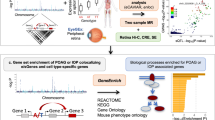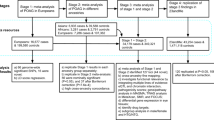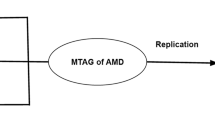Abstract
We report a genome-wide association study for open-angle glaucoma (OAG) blindness using a discovery cohort of 590 individuals with severe visual field loss (cases) and 3,956 controls. We identified associated loci at TMCO1 (rs4656461[G] odds ratio (OR) = 1.68, P = 6.1 × 10−10) and CDKN2B-AS1 (rs4977756[A] OR = 1.50, P = 4.7 × 10−9). We replicated these associations in an independent cohort of cases with advanced OAG (rs4656461 P = 0.010; rs4977756 P = 0.042) and two additional cohorts of less severe OAG (rs4656461 combined discovery and replication P = 6.00 × 10−14, OR = 1.51, 95% CI 1.35–1.68; rs4977756 combined P = 1.35 × 10−14, OR = 1.39, 95% CI 1.28–1.51). We show retinal expression of genes at both loci in human ocular tissues. We also show that CDKN2A and CDKN2B are upregulated in the retina of a rat model of glaucoma.
This is a preview of subscription content, access via your institution
Access options
Subscribe to this journal
Receive 12 print issues and online access
$209.00 per year
only $17.42 per issue
Buy this article
- Purchase on SpringerLink
- Instant access to full article PDF
Prices may be subject to local taxes which are calculated during checkout




Similar content being viewed by others
References
Quigley, H.A. & Broman, A.T. The number of people with glaucoma worldwide in 2010 and 2020. Br. J. Ophthalmol. 90, 262–267 (2006).
Heijl, A. et al. Reduction of intraocular pressure and glaucoma progression: results from the Early Manifest Glaucoma Trial. Arch. Ophthalmol. 120, 1268–1279 (2002).
Stone, E.M. et al. Identification of a gene that causes primary open angle glaucoma. Science 275, 668–670 (1997).
Pasutto, F. et al. Heterozygous NTF4 mutations impairing neurotrophin-4 signaling in patients with primary open-angle glaucoma. Am. J. Hum. Genet. 85, 447–456 (2009).
Rao, K.N. et al. Variations in NTF4, VAV2, and VAV3 genes are not involved with primary open-angle and primary angle-closure glaucomas in an indian population. Invest. Ophthalmol. Vis. Sci. 51, 4937–4941 (2010).
Thorleifsson, G. et al. Common variants near CAV1 and CAV2 are associated with primary open-angle glaucoma. Nat. Genet. 42, 906–909 (2010).
Green, C.M. et al. How significant is a family history of glaucoma? Experience from the Glaucoma Inheritance Study in Tasmania. Clin. Experiment. Ophthalmol. 35, 793–799 (2007).
Hewitt, A.W. et al. Sensitivity of confocal laser tomography versus optical coherence tomography in detecting advanced glaucoma. Clin. Experiment. Ophthalmol. 37, 836–841, quiz 903–904 (2009).
Painter, J. et al. Genome-wide association study identifies a locus at 7p15.2 associated with the development of endometriosis. Nat. Genet. 43, 51–54 (2010).
Beavis, W. The power and deceit of QTL experiments: lessons from comparative QTL studies. in Proceedings of the Corn and Sorghum Industry Research Conference 250–266 (American Seed Trade Association, Washington, D.C., USA, 1994).
Folkersen, L. et al. Relationship between CAD risk genotype in the chromosome 9p21 locus and gene expression. Identification of eight new ANRIL splice variants. PLoS ONE 4, e7677 (2009).
Pasmant, E. et al. Characterization of a germ-line deletion, including the entire INK4/ARF locus, in a melanoma-neural system tumor family: identification of ANRIL, an antisense noncoding RNA whose expression coclusters with ARF. Cancer Res. 67, 3963–3969 (2007).
Ebneter, A., Casson, R.J., Wood, J.P. & Chidlow, G. Microglial activation in the visual pathway in experimental glaucoma: spatiotemporal characterization and correlation with axonal injury. Invest. Ophthalmol. Vis. Sci. 51, 6448–6460 (2010).
Xin, B. et al. Homozygous frameshift mutation in TMCO1 causes a syndrome with craniofacial dysmorphism, skeletal anomalies, and mental retardation. Proc. Natl. Acad. Sci. USA 107, 258–263 (2010).
Iwamuro, S., Saeki, M. & Kato, S. Multi-ubiquitination of a nascent membrane protein produced in a rabbit reticulocyte lysate. J. Biochem. 126, 48–53 (1999).
Zhang, Z. et al. Molecular cloning, expression patterns and subcellular localization of porcine TMCO1 gene. Mol. Biol. Rep. 37, 1611–1618 (2010).
Helgadottir, A. et al. A common variant on chromosome 9p21 affects the risk of myocardial infarction. Science 316, 1491–1493 (2007).
Scott, L.J. et al. A genome-wide association study of type 2 diabetes in Finns detects multiple susceptibility variants. Science 316, 1341–1345 (2007).
Bilguvar, K. et al. Susceptibility loci for intracranial aneurysm in European and Japanese populations. Nat. Genet. 40, 1472–1477 (2008).
Shete, S. et al. Genome-wide association study identifies five susceptibility loci for glioma. Nat. Genet. 41, 899–904 (2009).
Jarinova, O. et al. Functional analysis of the chromosome 9p21.3 coronary artery disease risk locus. Arterioscler. Thromb. Vasc. Biol. 29, 1671–1677 (2009).
Gonzalez, S. & Serrano, M. A new mechanism of inactivation of the INK4/ARF locus. Cell Cycle 5, 1382–1384 (2006).
Williams, T.M. et al. Combined loss of INK4a and caveolin-1 synergistically enhances cell proliferation and oncogene-induced tumorigenesis: role of INK4a/CAV-1 in mammary epithelial cell hyperplasia. J. Biol. Chem. 279, 24745–24756 (2004).
Ramdas, W.D. et al. A genome-wide association study of optic disc parameters. PLoS Genet. 6, e1000978 (2010).
Price, A.L. et al. Principal components analysis corrects for stratification in genome-wide association studies. Nat. Genet. 38, 904–909 (2006).
Purcell, S. et al. PLINK: a tool set for whole-genome association and population-based linkage analyses. Am. J. Hum. Genet. 81, 559–575 (2007).
Li, Y., Willer, C., Sanna, S. & Abecasis, G. Genotype imputation. Annu. Rev. Genomics Hum. Genet. 10, 387–406 (2009).
Pruim, R. et al. LocusZoom: regional visualization of genome-wide association scan results. Bioinformatics 26, 2336–2337 (2010).
Barrett, J.C., Fry, B., Maller, J. & Daly, M.J. Haploview: analysis and visualization of LD and haplotype maps. Bioinformatics 21, 263–265 (2005).
R Development Core Team. R: A Language and Environment for Statistical Computing. (R Foundation for Statistical Computing, Vienna, Austria, 2008).
Pfaffl, M.W. A new mathematical model for relative quantification in real-time RT-PCR. Nucleic Acids Res. 29, e45 (2001).
Acknowledgements
This research was funded by the National Health and Medical Research Council (NHMRC) of Australia, project grant 535074 to J.E.C., A.W.H., S.M., D.A.M. and K.P.B. We also thank the following organizations for their financial support: Royal Australian and New Zealand College of Ophthalmologists (RANZCO) Eye Foundation, Clifford Craig Medical Research Trust, Ophthalmic Research Institute of Australia (ORIA), Pfizer Australia, Glaucoma Australia, American Health Assistance Foundation (AHAF), Peggy and Leslie Cranbourne Foundation, Jack Brockhoff Foundation, and National Eye Institute (NEI) Project Grant (2007-2010). The Australian Twin Registry is supported by an NHMRC Enabling Grant (2004-2009). The Queensland Institute of Medical Research (QIMR) Study was also supported by grants from the NHMRC (241944, 339462, 389927, 389875, 389891, 389892, 389938, 443036, 442915, 442981, 496610, 496739, 552485 and 552498), the Cooperative Research Centre for Discovery of Genes for Common Human Diseases, Cerylid Biosciences (Melbourne) and donations from N. and S. Hawkins.
S.M. and K.P.B. are supported by NHMRC Career Development Awards (496674, 613705 and 595944). D.R.N. was supported by the NHMRC Fellowship (339462 and 613674) and Australian Research Council Future Fellowship (FT0991022) schemes. G.W.M., M.A.B. and J.E.C. are supported by the NHMRC Fellowships Scheme. D.A.M. is a recipient of the Pfizer Australia Senior Research Fellowship.
We thank all participants of the Australian and New Zealand Registry of Advanced Glaucoma (ANZRAG), the Glaucoma Inheritance Study in Tasmania (GIST), the Blue Mountains Eye study (BMES), the Queensland Institute of Medical Research (QIMR) study, Oxford Endometriosis Gene Study (OXEGENE), the Nurses Health Study (NHS) and the Brisbane Adolescent Twin Study (BATS) and the staff who have collated clinical data and DNA samples over many years. We thank Glaucoma Australia and Endometriosis Associations for supporting study recruitment. We thank S. Nicolaides, Queensland Medical Laboratory and SA Pathology for pro bono collection and delivery of blood samples and other pathology services for assistance with blood collection.
We thank B. Usher, S. Thorpe, A. Kuot, A. McMellon, M. Ring, T. Straga, L. Kearns, J. Barbour, S. Staffieri, J. Ruddle, P. Coleman, M.J. Wright, M.J. Campbell, A. Caracella, L. Bowdler, S. Smith, S. Gordon, K. Zondervan, S. Treloar, J. Painter, B. Haddon, D. Smyth, H. Beeby, O. Zheng and B. Chapman for their input to project management, databases, sample and data collection, sample processing and genotyping. We are grateful to the many research assistants and interviewers for assistance with the studies contributing to the collections used in this project.
We gratefully acknowledge the use of the Wellcome Trust Case Control Consortium 1958 British Birth Cohort data.
Author information
Authors and Affiliations
Contributions
K.P.B., S.M., A.W.H., D.A.M. and J.E.C. were involved in the concept and design of this study. A.W.H., R.A.M., R.C., J.L., E.S., J.J.W., N.G.M., G.W.M., P.M., D.A.M. and J.E.C. recruited participants. Genotyping was performed by K.P.B., P.D., A.C.V., A.K.H., J.J.W., D.R.N., N.G.M., G.W.M., M.A.B. and J.E.C. Statistical analysis was undertaken by K.P.B., S.M., J.Z.L., P.L., E.R., D.R.N. and M.A.B. Direct sequencing was performed by K.P.B. and A.C., S.S., G.C., R.C. and J.W. performed the immunohistochemistry and gene expression studies. K.P.B., S.M. and J.E.C. wrote the initial draft. All authors critically revised and provided final approval of this manuscript.
Corresponding author
Ethics declarations
Competing interests
The authors declare no competing financial interests.
Supplementary information
Supplementary Text and Figures
Supplementary Figures 1 and 2, Supplementary Tables 1–5 and Supplementary Note. (PDF 519 kb)
Rights and permissions
About this article
Cite this article
Burdon, K., Macgregor, S., Hewitt, A. et al. Genome-wide association study identifies susceptibility loci for open angle glaucoma at TMCO1 and CDKN2B-AS1. Nat Genet 43, 574–578 (2011). https://doi.org/10.1038/ng.824
Received:
Accepted:
Published:
Issue Date:
DOI: https://doi.org/10.1038/ng.824



